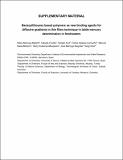Por favor, use este identificador para citar o enlazar a este item:
http://hdl.handle.net/10261/281517COMPARTIR / EXPORTAR:
 SHARE SHARE
 CORE
BASE CORE
BASE
|
|
| Visualizar otros formatos: MARC | Dublin Core | RDF | ORE | MODS | METS | DIDL | DATACITE | |

| Título: | Benzoylthiourea based polymers as new binding agents for diffusive gradients in thin films technique in labile mercury determination in freshwaters |
Autor: | Marrugo-Madrid, Siday; Fontàs, Clàudia; Kurt, Gülşah; Salazar-Camacho, Carlos; Salas-Moreno, Manuel; Gutiérrez-Mosquera, Harry; Marrugo-Negrete, José Luis; Díez, Sergi CSIC ORCID | Palabras clave: | Diffusive gradients in thin films Mercury Benzoylthiourea derivatives Sorption gels River water |
Fecha de publicación: | nov-2022 | Editor: | Elsevier | Citación: | Environmental Technology and Innovation 28: 102911 (2022) | Resumen: | In this study, the diffusive gradient in thin film (DGT) has been developed using three new materials derived from benzoylthiourea (PBTU, BTP1 and BTP2) for the determination of bioavailable mercury (Hg). The efficiency of these DGT devices was compared with the well-established 3-mercaptopropyl functionalized silica gel (3MFS) in laboratory and field conditions. It was found that PBTU lacked of consistency for handling and assembling in the DGT device, whereas the other two polymers provided mechanically stable binding gels and extracted satisfactorily Hg. However, BTP2 showed no correlation between Hg uptake and Hg present in the aqueous solution, and therefore, BTP1 gels was chosen as the binding layer used for DGT technique. The calculated diffusion coefficient of DGT-BTP1 was 4.0 10−6 cm 2 s−1 at 25 °C in 0.8 mm thick diffusion layer and 2.3% w/v of material in gel, whereas for DGT-3MFS, the D value was 9.1 × 10−6 cm 2 s−1. Moreover, it was found that neither the pH (range 4.5 – 9.5) nor the ionic strength (range 0.005–0.1 mol L−1) significantly affected the binding behavior of Hg (p > 0.05). Finally, the DGT-BTP1 devices were successfully used for in-situ measurements of Hg in Quito River (Colombia), impacted by artisanal gold mining, and were compared with DGT-3MFS. Results showed a good performance with values of the labile Hg concentration between 5 to 8% of the total Hg in water. This study demonstrates that benzoylthiourea based DGT is a useful tool for in situ monitoring of Hg in freshwaters. | Versión del editor: | https://doi.org/10.1016/j.eti.2022.102911 | URI: | http://hdl.handle.net/10261/281517 | DOI: | 10.1016/j.eti.2022.102911 |
| Aparece en las colecciones: | (IDAEA) Artículos |
Ficheros en este ítem:
| Fichero | Descripción | Tamaño | Formato | |
|---|---|---|---|---|
| 1-s2.0-S2352186422003340-main.pdf | Artículo principal | 643,62 kB | Adobe PDF |  Visualizar/Abrir |
| 1-s2.0-S2352186422003340-mmc1.pdf | Material suplementario | 156,66 kB | Adobe PDF |  Visualizar/Abrir |
CORE Recommender
SCOPUSTM
Citations
3
checked on 30-mar-2024
WEB OF SCIENCETM
Citations
2
checked on 26-feb-2024
Page view(s)
22
checked on 22-abr-2024
Download(s)
27
checked on 22-abr-2024
Google ScholarTM
Check
Altmetric
Altmetric
NOTA: Los ítems de Digital.CSIC están protegidos por copyright, con todos los derechos reservados, a menos que se indique lo contrario.
